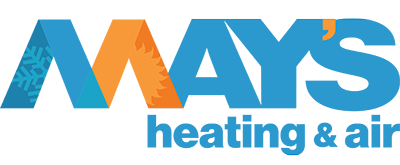
Ceiling fans are one of the most underappreciated ways to enhance comfort and cut energy costs. By improving air circulation and supporting your HVAC system, ceiling fans and energy efficiency are truly a match made in heaven. They offer a practical, eco-friendly way to stay cool while easing strain on your AC—even preventing unnecessary air conditioning repair.
In this blog, the experts at May's Heating & Air explain how ceiling fans can keep you cool while saving you money thanks to increased HVAC efficiency. We'll also offer some HVAC efficiency tips that put to good use ceiling fans.
Comfort vs. Temperature: Getting Comfortable with the Wind-Chill Effect Indoors
Ceiling fans don’t actually lower the room temperature—they make your home more comfortable by moving air over your skin. This is called the wind-chill effect, and it can make a room feel up to 4 degrees cooler without adjusting the thermostat. That means you feel less hot and enjoy the benefits of indoor air circulation from your ceiling fan while using less AC—helping reduce your electric bill in summer.
The Best of Both: Advantages of Pairing Fans and Air Conditioning Together
There are several benefits to using ceiling fans and air conditioning together, especially during the warmer months. By using both, you maximize HVAC efficiency and keep your home cooler with less effort from your cooling system.
Benefits of using ceiling fans and AC together:
- Ceiling fans help lower HVAC load by distributing cool air more evenly throughout a room. Limiting HVAC stress is important, because it can save you from a breakdown that could result in premature AC or furnace installation.
- Using ceiling fans improves your indoor comfort by getting rid of warm pockets and enhancing circulation.
- Pairing ceiling fans and AC can lower your utility usage. If you have a home automation system, you can even modify your smart thermostat settings to increase the temperature slightly while your ceiling fan is running.
Clockwise vs. Counterclockwise Ceiling Fan Rotation: What Direction to Spin in Summer and Winter?
To get the most out of your ceiling fans year-round, it’s important to set the blades to rotate in the right direction for the season. The direction impacts how air circulates, which can either cool you down or redistribute heat so you feel warmer.
When to rotate ceiling fans counterclockwise
In the summer, ceiling fans should turn counterclockwise at a higher speed. This creates a breeze that pushes cool air downward, increasing the wind-chill effect and creating a cooler sensation.
When it's best to spin ceiling fans clockwise
In the winter, set your fan to rotate clockwise on a slower speed. This gently pulls cool air upward and circulates heated air down to where you can feel it, making the space feel cozier without adjusting your thermostat.
How to Pick Out the Best Ceiling Fan for My Home
Picking the best ceiling fan depends on a few key factors, such as blade design, airflow rating and room dimensions. First, look for fans with a good blend of ECFM airflow and blade pitch to ensure efficient air movement in your space:
- ECFM refers to how much air a fan pushes—the cubic feet per minute, or CFM—per watt of electricity it uses. Fans with greater ECFM are the most energy efficient.
- Blade pitch refers to the tilt of the blades. A steeper blade pitch moves more air but can also stress the fan’s motor.
Also, consider room size when sizing a ceiling fan—a fan that’s too small won’t move as much air as you'd like, while one that’s too large may be overpowering for the room.
Increase Your HVAC Efficiency With Help from May's Heating & Air
At May's Heating & Air, our HVAC specialists can help you stay comfortable while easing the burden on your heating and cooling systems. From energy-saving ceiling fan tips and air conditioning installation to smart thermostats and furnace repair, we offer comprehensive services that fit your lifestyle. Schedule your appointment by calling 301-834-1468 today.
